History of Samoa - Picture
More about World War 1
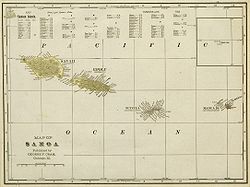
|
|
History of Samoa

Picture - Chromograph map of Samoa - George Cram 1896
Samoa before the arrival of Europeans
Archeologists place the earliest human settlement of the Samoan archipelago at around 1500 B.C. This date is based upon the ancient lapita pottery shards found throughout the islands. Samoan oral history, however, extends only as far back as 1000 A.D. Whatever occurred between 1500 B.C. and 1000 A.D. remains a mystery, though this may have been the period of great migrations that led to the settlement of present-day Polynesia: Samoa is recognized as the center of Polynesia, whence people migrated eastward to the Marquesas, southward to Niue and the Pukapuka islands of Rarotonga, and northward to the Tokelau and Tuvalu island groups; in all these islands, oral tradition is maintained of ancestral voyages from the Samoan islands. These migrations reflect the extraordinary courage of these seafaring people in navigating without instruments to sail throughout the vast Pacific Ocean.
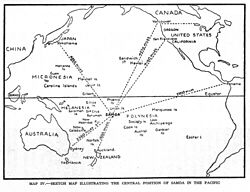
Picture - 1934 Sketch map showing the central position of the Samoa Islands in the Pacific.
Another mystery is why the making of pottery suddenly stopped. There is no oral tradition in reference to pottery use, but it abounds with proverbs on the starmounts used in the ancient sport of pigeon snarling, once popular among Samoan nobility. Linguistically, the Samoan language is part of the Austronesian language family.
Prior to the arrival of the Europeans in the early 1700s, Samoa's history was interwoven with that of certain chiefdoms of Fiji as well as the history of the kingdom of Tonga. According to legend, Samoa shares the common Polynesian ancestor of Tagaloa; according to many legends, Samoa was Tagaloa's first creation. The oral history of Samoa preserves the memories of many battles fought between Samoa and neighboring islands. Too, intermarriage of Tongan and Fijian royalty to noble Samoan women has helped build close relationships between these island nations that exists even to the present day; these royal blood ties are acknowledged at special events and cultural gatherings. Samoan folklore tells of the arrival of two maidens from Fiji who brought the art of tatau, or tattoo, to Samoa, whence came the traditional Samoan malofie (malofie is also known as pe'a for men and as malu for women). Oral traditions record the use of the Samoan fine mat as a garment of atonement, draped over a Samoan maiden to pardon her from a Tongan king's wrath and criminal indictment.
Bestowal of the highly reverential title "Malietoa" marked a period in Samoan history when the islands were officially recognized as independent of Tongan rule. The title refers to the parting words of Tongan warriors, "Malie toa, malie tau" (literally, "Brave warrior, bravely fought"). Hence, the title was amended as part of the more ancient royal courts and titles of Tui-Aana, Tui-Atua.
These tales reflect Samoa's colorful and at times fierce past.
European contact
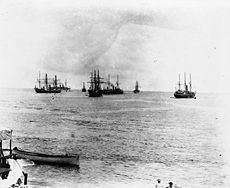
Picture - German, British and American warships in Apia harbour, 1899.
Contact with Europeans began in the early 18th century but did not intensify until the arrival of the British. In 1722, Dutchman Jacob Roggeveen was the first European to sight the islands. Missionaries and traders arrived in the 1830s. Halfway through the 19th century, the United Kingdom, Germany and the United States all claimed parts of the kingdom of Samoa, and established trade posts.
High Chief Malietoa Leaupepe died in 1898 and was succeeded by Malietoa Tooa Mataafa. The US and British consuls supported Malietoa Tanumafili I, Leaupepe's son.
US and British warships, including the USS Philadelphia shelled Apia on March 15, 1899.
Division of islands
The Samoa Tripartite Convention, a joint commission of three members composed of Bartlett Tripp for the United States, C. N. E. Eliot, C.B. for Great Britain, and Freiherr Speck von Sternburg for Germany, agreed to divide the islands. Germany received the western part, (later known as Western Samoa), containing Upolu and Savaii (the current Samoa) and other adjoining islands. These islands became known as German Samoa. The US accepted Tutuila and Manu'a, which currently comprise the U.S. territory of American Samoa. In exchange for Britain ceding claims in Samoa, Germany transferred their protectorates in the North Solomon Islands. The monarchy was abolished.
Independence
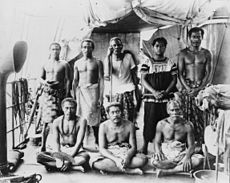
Picture - Exiled group aboard German warship taking them to Saipan. Standing 3rd from the left is Lauaki Namulauulu Mamoe, 1909.
From 1908, with the establishment of the Mau movement ("opinion movement"), Western Samoans began to assert their claim to independence. The early beginnings of the national Mau movement began in 1908 with the 'Mau a Pule' resistance on Savai'i, led by orator chief Lauaki Namulau'ulu Mamoe. Lauaki and Mau a Pule chiefs, wives and children were exiled to Saipan in 1909. Many died in exile.
Shortly after the outbreak of World War I, in August 1914, New Zealand sent an expeditionary force to seize and occupy German Samoa. Although Germany refused to officially surrender the islands, no resistance was offered and the occupation took place without any fighting. New Zealand continued the occupation of Western Samoa throughout World War I. In 1919, under the Treaty of Versailles, Germany relinquished its claims to the islands.
The Mau movement gained momentum with Samoa's royal leaders becoming more visible in supporting the peoples movement but strongly opposed violence. On December 28, 1929 Tupua Tamasese was shot along with eleven others during a peaceful demonstration in Apia. Tupua Tamasese died the following day, with the advice that no more blood should be shed.
New Zealand administered Western Samoa first as a League of Nations Mandate and then as a United Nations trusteeship until the country received its independence on January 1, 1962 as Western Samoa. Samoa's first prime minister following independence was paramount chief Fiame Mata'afa Faumuina Mulinu'u II.
Samoa was the first Polynesian people to be recognized as a sovereign nation in the 20th century. In 1977, Queen Elizabeth II visited the Samoa during her tour of the Commonwealth.
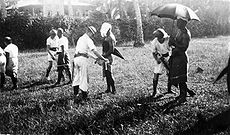
Picture - New Zealand sailors removing the white strip from lava-lava, the insiginia of the Mau uniform, circa 1930
In July 1997 the constitution was amended to change the country's name from "Western Samoa" to "Samoa." Samoa had been known simply as "Samoa" in the United Nations since joining the organization in 1976. The neighboring U.S. territory of American Samoa protested the move, feeling that the change diminished its own Samoan identity. American Samoans still use the terms "Western Samoa" and "Western Samoans."
In 2002, New Zealand's prime minister Helen Clark formally apologized for two incidents during the period of New Zealand's administration: a failure in 1918 to quarantine the SS Talune, which carried the 'Spanish 'flu' to Samoa, leading to an epidemic which devastated the Samoan population, and the shooting of leaders of the non-violent Mau movement during a ceremonial procession in 1929.
In 2007, Samoa's first Head of State, His Highness Malietoa Tanumafili II, died at the age of 95. He held this title jointly with Tupua Tamasese Lealofi until his death in 1963. The late Malietoa Tanumafili II was Samoa's Head of State for 45 years. He was the son of Malietoa Tanumafili I, who was the last Samoan king recognized by Europe and the Western World.
Samoa's current Head of State is His Highness Tui-Atua Tupua Tamasese Tupuola Efi, who was anointed the Head of State title with the unanimous endorsement of Samoa's Parliament. A symbol of traditional Samoan protocol in alignment with Samoan decision making stressing the importance of consensus in the 21st century.
Eustis, Nelson. 1979. Aggie Grey of Samoa. Hobby Investments, Adelaide, South Australia. 2nd printing, 1980. ISBN 0-9595609-0-4.
More aircraft.
Source: WikiPedia